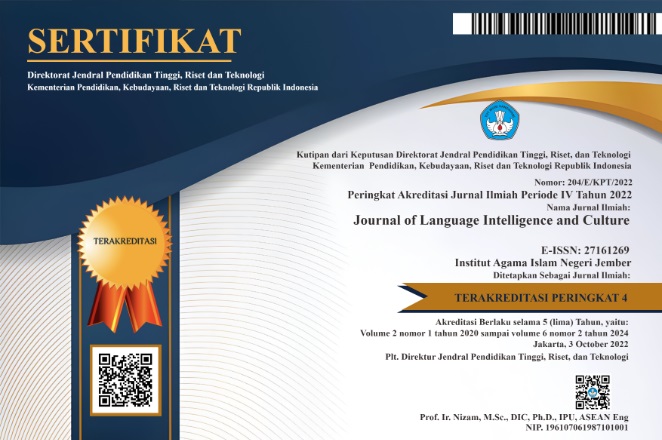English for Specific Purposes: Needs Analysis of EFL Learning Activites for Physical Education Students
DOI:
https://doi.org/10.35719/jlic.v7i1.638Keywords:
Need analysis, EFL for physical education students, English for Specific PurposesAbstract
This study examines the English language needs of Physical Education EFL students at Dehasen University, Indonesia, using the English for Specific Purposes (ESP) approach. It fills a gap in ESP research about the specific needs of Physical Education students in Indonesia. A mixed-methods design was used, collecting data from 42 students via questionnaires and from interviews with one English lecturer and one Physical Education lecturer. Data were analyzed using descriptive statistics and thematic coding. Results show that 95% of students consider English important, especially speaking (76%) and listening (10%) skills for communication in academic practicum settings. The main challenges reported were listening (40%) and speaking (30%), while writing was the lowest priority. Most students are motivated to learn English for work (55%) and communication (31%). Lecturers agree on teaching integrated skills but emphasize oral communication and pronunciation. The findings suggest ESP curricula should focus on sports-related vocabulary and practical communication tasks. Diverse teaching methods are recommended to improve student engagement and language learning. This study offers practical recommendations for syllabus design that meet the academic and professional needs of Physical Education students, emphasizing communicative competence—especially speaking and listening—to prepare them for future careers.
References
Alsamadani, H. A. (2017). Needs analysis in ESP context: Saudi engineering students as a case study. Advances in Language and Literary Studies, 8(6), 58–68. https://doi.org/10.7575/aiac.alls.v.8n.6p.58
Al Tamimi, A., & Shuib, M. (2009). Motivation and attitudes towards learning English among students in non English majors. English Language Teaching, 2(4), 87–101.
Basturkmen, H. (2018). Developing courses in English for specific purposes. Palgrave Macmillan.
Damanik, W., Sinambela, E., & Pasaribu, A. N. (2021). Needs analysis of English for specific purposes at Politeknik Gihon. Journal of English Educational Study (JEES), 4(1), 79–88. https://doi.org/10.31932/jees.v4i1.1157
Davis, J., & Jenkins, R. (2018). Writing skills development in ESP contexts: Challenges and strategies. Journal of English for Academic Purposes, 35, 50–62.
Farah, R. R. (2021). Exploring the English needs of mechanical engineering students in ESP class: Indonesian university context. Al Taʿlim Journal, 28(1), 76–82. https://doi.org/10.15548/jt.v28i1.627
Gardner, R. C. (1985). Social psychology and second language learning: The role of attitudes and motivation. Edward Arnold.
Hutchinson, T., & Waters, A. (1987). English for specific purposes. Cambridge University Press.
Indrasari, N. (2016). English for specific purposes: A needs analysis at the second semester of physics education students of IAIN Raden Intan Lampung in the academic year of 2015/2016. English Education: Jurnal Tadris Bahasa Inggris, 9(1), 161–172. https://doi.org/10.24042/ee-jtbi.v9i1.425
Karim, F., & Rahman, M. (2023). Reading technical texts in sports: Vocabulary and discourse structure. Sports Language Journal, 9(3), 200–215.
Li, X. (2019). Listening challenges in domain specific contexts: The case of sports instruction. Language Learning Journal, 47(3), 320–335.
Mahmud, M., & Safitri, R. (2021). Speaking as a key skill in vocational and health education settings in Indonesia. Journal of English Vocational Studies, 5(1), 11–25.
Martin, P., & Kim, J. (2019). The role of listening in improving speaking performance in professional settings. TESOL Quarterly, 53(4), 1200–1215.
Munir, S. (2014). Pengembangan materi ajar Bahasa Inggris untuk agen travel (sebuah kajian English for occupational purposes). Pengembangan Humaniora, 14(3), 260–274.
Nation, I. S. P., & Macalister, J. (2010). Language curriculum design. Routledge.
Nguyen, T., & Boers, F. (2020). EFL learners’ difficulties with spontaneous speech: Causes and solutions. Language Teaching Research, 24(5), 600–617.
Putra, A. R., & Pradana, A. (2023). Strategies used by high, medium and low achieving EFL students in learning English. Journal of Linguists and English Teaching, 9(2), 249–259. https://doi.org/10.29300/ling.v9i2.12477
Rahman, M. (2015). English for specific purposes (ESP): A holistic review. Universal Journal of Educational Research, 3(1), 24–31. https://doi.org/10.13189/ujer.2015.030104
Richard, J. C. (1997). From reader to reading teacher: Issues and strategies for second language classrooms. Cambridge University Press.
Richard, J. C. (2001). Curriculum development in language teaching. Cambridge University Press.
Richards, J. C., & Renandya, W. A. (2002). Methodology in language teaching: An anthology of current practice. Cambridge University Press.
Robinson, P. (1991). ESP today: A practitioner’s guide. Prentice Hall.
Rossignol, J., & Mayer, A. (2021). Listening comprehension in physical education: Challenges and strategies. Journal of Sports Linguistics, 8(2), 90–105.
Tsang, A., & Wong, B. (2002). Understanding conversation comprehension in English learning. In J. C. Richards & W. A. Renandya (Eds.), Methodology in language teaching (pp. 150–165). Cambridge University Press.
Widianingsih, I., & Listyaningrum, D. (2019). English needs analysis for vocational students in Indonesia. Journal of Language and Education, 5(2), 77–89.)
Wulandari, S., Putri, N., & Susanto, H. (2016). The role of ESP in vocational education: A needs analysis. Journal of Vocational Education Studies, 4(3), 45–58.
Zhang, L. (2022). Task based speaking activities for ESP learners in professional domains. English Language Teaching, 15(2), 90–102.
Zhou, Y. (2018). Limitations of general English teaching in non English majors. Journal of Language Teaching and Learning, 8(1), 15–29.
Downloads
Published
How to Cite
Issue
Section
License
Copyright (c) 2025 Aziiz Rahman Putra, Ami Pradana, Azizatul Banat, Barata Harsena Dewa

This work is licensed under a Creative Commons Attribution-ShareAlike 4.0 International License.













